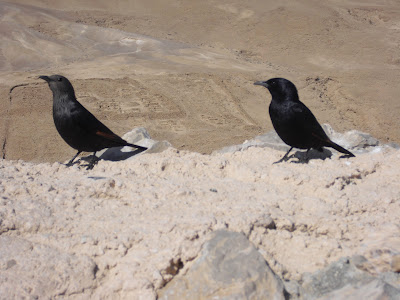Driving from Tel Aviv down almost 1400 ft. below sea level to the Dead Sea, crossing time and habitat, we stopped short to let a herd of roughly three dozen camels gallump across a major road. The sound of jet engines were still reverberating in my head when we spotted these ungainly beasts whose ancestors had caravanned over the ancient Spice Road, and I thought to myself - this is Israel; camels and high-rises, technology and Roman ruins, synagogues, mosques, churches and the largest Bahai Temple in the world all co-existing in the most talked about, written about, screamed about place on the planet.
Land in Israel on a Friday morning, drive to the Dead Sea, and you will find no screaming, hateful hordes. Instead, where Israel, the West Bank and Jordan all share a common water body, there's surprising calm. Tourists come to bob in the densest, most mineral-rich water on earth and avail themselves of mud-wraps and other spa treatments, new Russian immigrants have staked their claim to the few Dead Sea Product shops in town, and these Dead Sea shores and water provide a profitable skin-care industry for both Israel and Jordan. The Jordan River flows from Lake Kineret in the north (aka Sea of Galilee) to the Dead Sea, and the land along most of its west bank (though not right here) is otherwise known to the world as, um, The West Bank.
 |
| Dead Sea Israel at 1,400 feet below sea level, the lowest point on earth |
 |
| Dead Sea at Dusk The hills less than a mile across belong to Jordan |
 |
| Peace and Tranquility as the sun sets over the Jordanian hills on the Dead Sea (from Israel side) |
 |
| Dove and pigeon nest compartments Masada, Israel |
Overlooking the Dead Sea is Masada - King Herod's Palace turned Jewish rebel holdout during the Roman sacking of Jerusalem in 70AD. There are now questions about the thousand or so Jews who fled Jerusalem to find temporary refuge before purportedly committing suicide rather than submit to the Romans who had set up camps surrounding the hilltop fortress for months before breaching its walls. Aside from the fact that committing suicide for any reason is prohibited by Jewish Law (which made the Masada story rather troubling), the one Jewish-Roman eyewitness, Josephus, wrote nothing of finding nearly a thousand bodies after the Romans stormed the hill. In fact, archeologists never found skeletons or evidence of mass graves there. What they did find were radiant-heat and spacious Roman steam-rooms- built for Herod, innovative and modern - a complex cistern system that held months worth of water in the hottest and driest time of year, ruins of pigeon and dove nesting rooms, and large dried food storage areas.
 |
| Birds on Masada overlooking what's left of Roman encampments below from 73AD |
Moving north along the Dead Sea, we came to one of my favorite oases; En Gedi. I used to travel with Israeli friends to this waterfall in the middle of the Judaean Desert, where we'd strip down to bathing suits and swim under sweet cascading water. Now, the water here, like everywhere in the Middle East, is drying up. Natural pools are smaller and closed to swimmers, but David's Waterfall is still a spectacular site. On the mile or so hike (not for the faint of heart or for those who can't make it up slippery rock steps and gravel paths), you'll see strange wildlife, like these tree-climbing groundhog-like rodents, called Rock Hyrax (a Dr. Seuss name if there ever was one and perfectly suited to the creature).
 |
| Creaters in Ein Gedi, Israel |
 |
| "Davids Waterfall" En Gedi, Israel |
 |
| The pool at the base of David's Waterfall En Gedi, Israel |
 |
| Dipping toes in the En Gedi creek Israel |
From En Gedi, it's just an hour's drive to Jerusalem, and if you want to see this center of World Religion in the most dramatic way, plan to arrive late afternoon around sunset. Climb Mt. Scopus for the best panoramic view; this is what we did on a clear February night. The Dome of the Rock sits atop the site of the Jew's First Temple. The Church of the Holy Sepulcher is a few blocks away from what remains of the outlying courtyard wall of the Jewish Second Temple (known as the Kotel or Western Wall). An ancient wall - comprised of sections built in King Herod's time, around the turn of the last millennium, and in the 1500's - surround the Old City. Just outside the Old City walls, near the Jaffa Gate, there's a posh Waldorf Astoria Hotel going up and the upscale Mamilla Shopping promenade, signaling a change in the tastes and expectations of the new Israel tourist. This is not your Grandpa's Jerusalem.
 |
| The City of Jerusalem from Mt. Scopus, Israel |

Okay, sign me up! This is the second piece I've read about Israel in the past couple of weeks. Thanks for sharing.
ReplyDelete